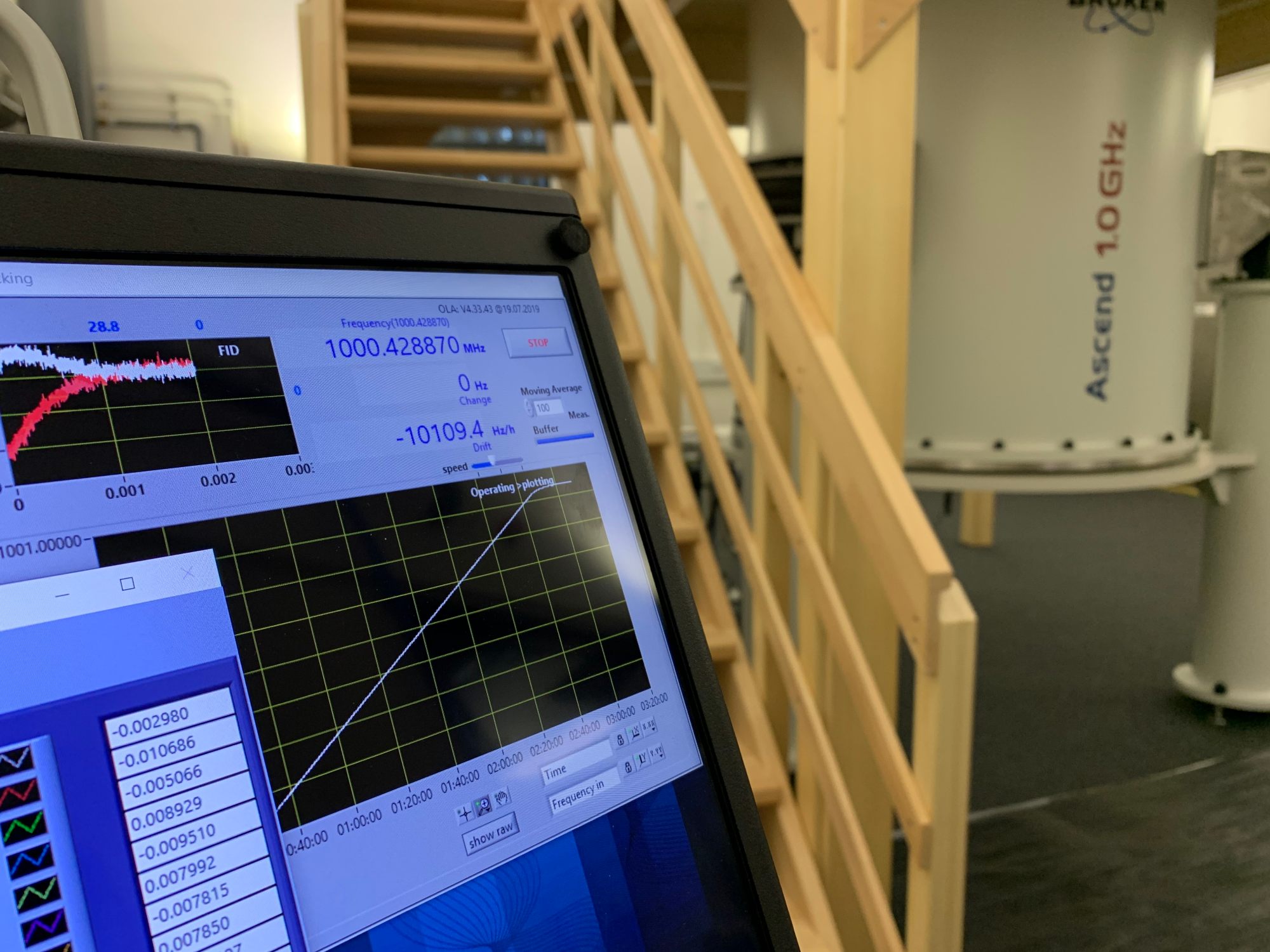Nov 18 2020
The University of Warwick has successfully energized a new high-powered magnet for nuclear magnetic resonance (NMR) in the United Kingdom.
 Console display showing the new NMR spectrometer (in the background) generating a 1 GHz magnetic field. Image Credit: University of Warwick.
Console display showing the new NMR spectrometer (in the background) generating a 1 GHz magnetic field. Image Credit: University of Warwick.
For the first time, this advancement will allow researchers to have access to a robust 1-GHz magnetic field to investigate the dynamics and structure with atomic resolution for an array of systems across chemistry, materials science, and life science in the United Kingdom.
The first 1-GHz solid-state NMR spectrometer in the UK will soon be running experiments, after an energization procedure, in which the instrument is cooled to just 2 °C above absolute zero.
The latest 1-GHz NMR spectrometer, which was financially supported with £8 million from the Engineering and Physical Sciences Research Council (EPSRC), contributes to the National Research Facility for High-Field Solid-State NMR situated at the University of Warwick.
Promising applications for the novel technology will comprise enhanced pharmaceutical formulations for drug delivery, and also improved quality materials for catalysis and energy.
It is great that the Bruker engineers have successfully brought the new 1 GHz magnet to field at the first attempt—this will be a fantastic resource for the UK scientific community. NMR is a very powerful technology that has driven scientific advances in a diverse range of applications.
Steven Brown, Professor, Department of Physics, University of Warwick
Professor Brown is also the Director of the National Research Facility for High-Field Solid-State NMR.
He continued, “As a national facility we welcome researchers from UK universities to further their understanding of physical sciences, including pharmaceutical formulation and drug delivery, and energy and materials science, as well as life sciences, such as protein interactions and plant biomass. We are delighted that UK researchers will be able to benefit from this leading-edge NMR technology, which will stimulate new research in many different fields of application.”
We are very happy that the energization of the 1.0 GHz NMR magnet at the University of Warwick went smoothly. Reaching full field is a key milestone in a GHz-class spectrometer installation. Our engineers will now proceed with the homogenization of the magnet, and then continue with the installation of a number of NMR probes which will support the various research tasks that are planned.
Patrick Wikus, GHz-class NMR Program, Bruker
Wikus continued, “We look forward to seeing the exciting results the UK scientific community will undoubtedly achieve with this new instrument.”
NMR utilizes strong magnetic fields to offer a better understanding of the atomic-scale structure, dynamics, and disorder of complex systems.
The University of Warwick has the largest solid-state NMR facility in the United Kingdom, fitted with NMR technology spanning from 100 to 700 MHz. It also houses the existing 850 MHz spectrometer of the National Research Facility.
Researchers in industry and from the UK universities and research organizations can use the National Research Facility, with former studies covering wide-ranging research fields, like energy materials, battery research, and pharmaceuticals.
The latest 1-GHz NMR spectrometer will allow more PhD researchers from across the nation to be trained in a wide range of disciplines with the most sophisticated equipment.
Important high-end industrial research in various industries, such as catalysis and pharmaceuticals, will also gain considerably.
Financial support for the new NMR spectrometer was handled by EPSRC and it also came from BBSRC, MRC, and NERC—three research councils that have supported this funding of high-field NMR infrastructure in the United Kingdom.
Andrew Wright, Head of Programme, Capital Infrastructure, and John Hand, Head of Programme, Physical Sciences, from the Engineering and Physical Sciences Research Council stated, “EPSRC is committed to providing the analytical sciences community with the resources it requires to continue world-leading research in UK universities. This NMR system will be of enormous benefit not only to a wide range of engineering and physical sciences researchers, but also those in bioscience, medical and environmental science.”